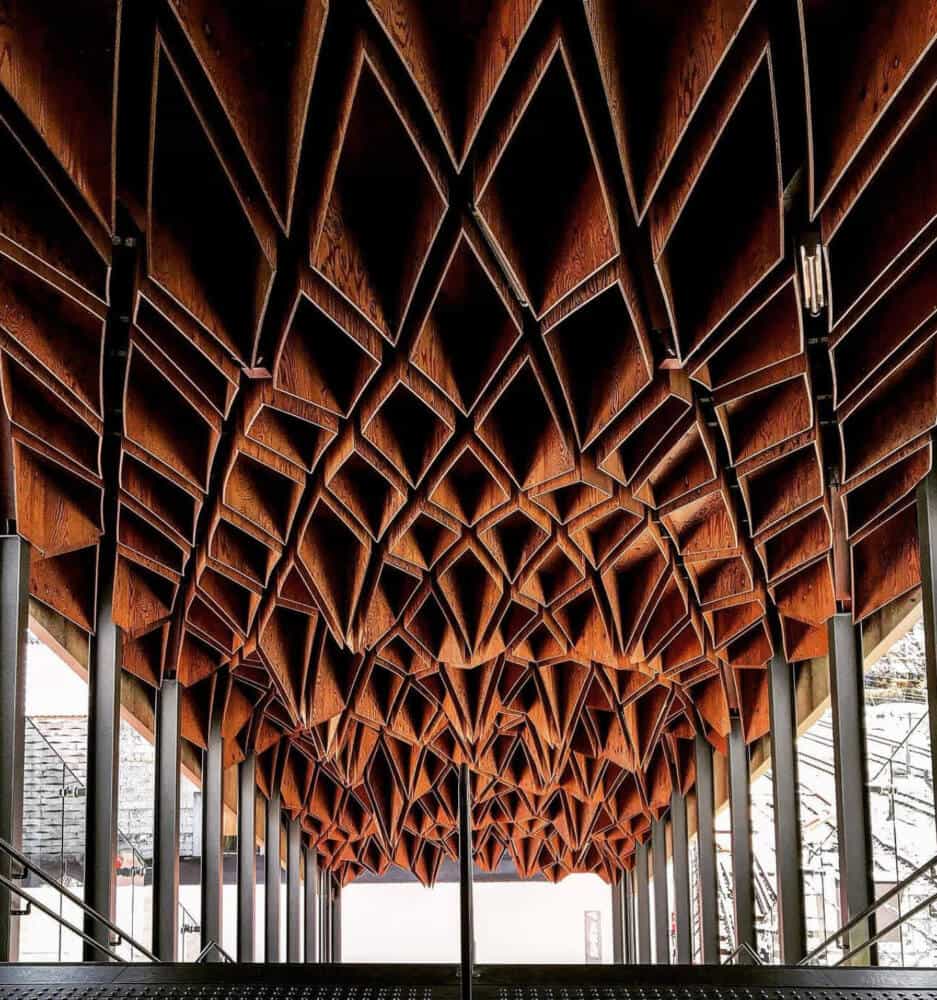Have you checked out the Hoshakuji Station in Japan? It is the most beautiful train station in Japan designed by Kengo Kuma and has also won award for its design! Check it out!
The Japanese countryside unveils many surprises, not least of which are the train stations that dot the landscape.
These are more than just transit points; they are capsules of charm and design ingenuity, blending in with the serene environs but also standing on their own as architectural feats.
Nestled in the town of Takanezawa, in the pastoral settings of Tochigi Prefecture, I find Hoshakuji Station, a testament to this elegant fusion of function and form.
Page Contents
Award Winning Train Station Design By Kengo Kuma Wowed The Travelers
Unassuming Train Station’s Exteriors Concealing Dynamic Interiors

From the outside, the station’s façade is modest, betraying none of its interior intricacy.
However, stepping inside, travelers are greeted by a stark contrast—an innovative, moving design under the stewardship of architect Kengo Kuma, an influential figure known for iconic structures such as the National Stadium and Takanawa Gateway Station.

An Evocative Journey Through Design
Upon entering, I am immediately drawn to the rich tapestry overhead—a ceiling of wooden panels arranged in intricate, geometric patterns, giving the illusion of a living, breathing entity.
As I ascend the concrete stairs flanked by wide glass windows, the sense of being in a static building dissipates, replaced by the enveloping dynamism of Kuma’s creation.


Effortless Navigation with Artistic Companion
The feeling of motion persists along sunlit corridors, where the wooden ceiling seems to guide travelers towards the heart of the station—the ticket gates.
Even as I purchase my ticket and move through, the ceiling’s artistic embrace lingers, offering a serene companionship through the building’s finalized stretch.

Warmth and Safety on the Way to Departure
As I make my way to the platforms, the station’s design ensures a snug and secure passage, with warm lighting enhancing the natural hues of the wood.
This is an element often overlooked in transit design yet so vital for the human experience within such spaces.
The Unexpected Wonder of Hoshakuji Station
For anyone who discovers Hoshakuji without forewarning, the station’s interior starkly opposes the simplicity of other stops along the line, promising a memorable experience that extends beyond mere transportation.
Adjacent to the station, Chokkura Plaza emerges as another point of interest, conceived with the same design philosophy—encouraging natural flow of light and air, with thoughtful use of rice husks paving its surface.
Integration and Regeneration Through Thoughtful Design
Kuma’s vision extends beyond aesthetics; it seeks to bridge the divide—quite literally.
The inclusion of a bridge as part of the station’s redesign fosters better connectivity between the east and west sides of the station, previously segregated by the tracks.
This architectural consideration has sparked a broader urban renewal, underscoring the potential of design to transform and unite communities.
My Final Thoughts on Hoshakuji Station
Visiting Hoshakuji Station, whether by chance or intent, leaves an indelible impression. Offering more than functionality, the station becomes a destination in itself for enthusiasts of exceptional architecture and design innovation.
It’s a must-visit for those in the vicinity of Utsunomiya, especially for those who appreciate when artistry and pragmatism coalesce.
For those wishing to delve into this blend of traditional charm and modern-day marvel, Hoshakuji Station’s details are as follows:
- Hoshakuji Station / 宝積寺駅
- Address: Tochigi-ken, Shioya-gun, Takanezawa-machi, Oaza Hoshakuji
- Website: Accessible for further information and visitor inquiries.
What is Kengo Kuma’s Notable Train Station in Tokyo?
The Takanawa Gateway Station stands out as one of Kengo Kuma’s most remarkable designs, celebrated for its architectural beauty. It is a modern interpretation of traditional elegance, seamlessly blended into Tokyo’s urban landscape.
Which Station Design by Kuma is Celebrated for Its Scenic Beauty?
The station renowned for its breath-taking beauty among Kuma’s works is the Takanawa Gateway Station. This station has received wide recognition for its unique design and has been hailed as reflective of Japan’s natural aesthetics.
Kengo Kuma’s Influence on the Aesthetic Appeal of the Station?
Kuma’s architectural design philosophy emphasizes harmony with the environment, which is evident in the beautiful Takanawa Gateway Station. His use of natural materials and fluid lines creates an inviting space that embodies both innovation and tradition.
Distinctive Attributes of Kuma’s Train Station Making It Beautiful?
- Curved Roofline: An undulating roof that mimics natural forms creates a visually appealing silhouette against the urban skyline.
- Material Fusion: Integration of wood with modern materials, giving a warm, yet contemporary feel.
- Open Spaces: The station features open, airy spaces that connect travelers to the surrounding cityscape.
A Compilation of Kengo Kuma’s Designed Stations Known for Their Design?
Besides Takanawa Gateway Station, Kuma has contributed to other significant station designs, including:
- Hoshakuji Station, rebuilt under his supervision in 2008.
- Numerous projects that celebrate both functional and aesthetic qualities.
Inspirations Behind Kuma’s Visually Impressive Station Design?
In designing Takanawa Gateway Station, Kuma drew inspiration from both Japan’s natural landscapes and its rich cultural heritage. He aimed to create a space that is a convergence point for the public, symbolizing Japan’s continual merging of tradition with progress.
My writing focuses on the various aspects of Japanese lifestyle, from traditional tea ceremonies and flower arrangement to modern fashion trends and pop culture. Through my articles, I aim to share my passion for Japan and provide readers with a glimpse into the rich and diverse world of Japanese culture.
I believe that the key to understanding Japanese lifestyle is to appreciate the balance between tradition and innovation. While Japan has a rich cultural heritage that dates back centuries, it is also a country that is constantly evolving and embracing new ideas and technologies.
Whether you’re interested in learning about the latest fashion trends in Tokyo, or want to explore the ancient art of calligraphy, my writing will take you on a journey through the many facets of Japanese lifestyle. So join me as we explore the beauty and complexity of this fascinating culture together!





